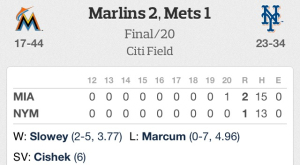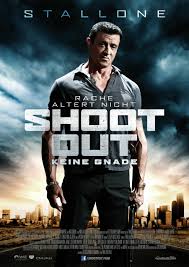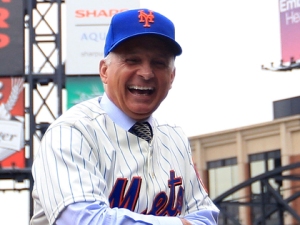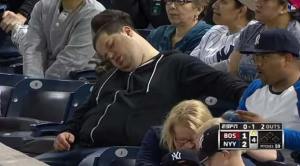So last night the Yankees and Red Sox started a game at around 7:00 p.m. They ended that game north of 2 in the morning, after 19 innings of baseball. 19 innings. The teams are underway again now, less than 12 hours later for their scheduled afternoon matchup.
When the schedule makers gave the typical day game after a night game, they hardly were suspecting that the teams would play a 7+ hour marathon the night before, but maybe they should have.
I’ve been to a 20 inning baseball game. I stayed the whole time between the Mets and Marlins in 2013. The game ended 2-1. When Miami closed it out in the bottom of the 20th, there were probably more people in the local Flushing CVS than there were at the ballpark.
Everyone seems to remember long baseball games fondly, as historical footnotes. A typical “I remember when” to distinguish a point in time over an often forgettable 162 game stretch. But the sad truth of the matter is, the one that no one wants to admit, is that extra inning baseball games suck.
“Free baseball!” they say as the excitement of overtime looms large. The 10th inning certainly is exciting. Managers are forced to make pressurized decisions, where one right pinch hitter or one wrong move to the bullpen could cost them the game. Hitters are looking for that one chance at glory, for a mob celebration of a walk-off and a pie in the face after the game. Pitchers who aren’t usually closers and late-inning workers must come in to a situation where they need to have their best stuff or risk putting an L in their right column.
All of that is great. But some time around the 12th inning, all of that shine turns to shit. Players become tired, swinging for the fences on every pitch instead of trying to start a rally so they can please just go home and get some rest. Managers run out of options. Relief pitchers have to bat. Position players have to pitch. Umpires give so little of a shit. The chances of injury double or even triple and not to mention there’s that pesky afternoon game likely looming over their heads the next day.
By the time one team finally gets the game-winning run, it’s less of a celebration and more of a relief.
Sports like hockey and soccer have adopted ways to combat this “play all-night” scenario, and they are called shootouts. They are unnatural, they feel cheap, they aren’t traditional. These are all true. But god damn if they aren’t exciting.
Baseball traditionalists will turn up their nose at me for daring to suggest breaking away from precious traditions because “baseball is a game with a rich history and we can’t jeopardize the traditions by trivializing the game and FART NOISEEEEEE”.
With new commissioner Rob Manfed claiming to care about the pace and length of Major League Baseball games, now is the time to make a change. Extra inning baseball needs to die and quick and painless death, and I’ve come up with a way to get rid of it.
Behold: The Baseball Shootout.
The Rules
First things first: After 9 innings, if two teams are tied, that becomes the final score of the game. Nothing from here on out affects the individual stats of the players (except for specific baseball shootout stats). No batting averages or ERA’s are in danger here. Got it?
If the Yankees and Red Sox are tied at 3 after 9 innings, the final score is 3-3. This is borrowed from soccer. The winning team will have their shootout score in parentheses which will determine the winner in the box score.
Anyways here’s how this works in a step-by-step basis.
1. The manager of each team resets their lineup based on the nine players currently in the batting order or with any bench players they wish to bring in as replacements.
The best hitters get the first crack at this, since the game will likely end after the first inning of the shootout, a team should be able to put it’s best players in a position. Your best guy was last up and didn’t get a hit? Good news, he can go right back in and give it another shot.
2. The road team gets first ups. They get three at-bats. That’s it.
That’s right, three. It doesn’t matter if you get out or not, or whether you get on base, that’s not important in this.
3. A single (or reaching first base in any capacity) is worth 1 point. A double is worth 2 points. Triple 3. Home run 5. No runners stay on base, after the three batters get their crack, the amount of points they score is added up and must be beaten or matched by the home team.
Let’s say for instance this was the case in the Yankees-Red Sox game last night.
Boston gets up first.
Pablo Sandoval grounds out he scored 0.
Dustin Pedroia gets a base hit he scored 1.
David Ortiz got a double he scored 2.
The Red Sox score was 3.
The Yankees now get a chance with their three best hitters to match or beat this score.
4. If the home team beats the score they win the game, if they score less the road team wins, if they tie another session is played, this time with the 4-5-6 batters in the lineup.
Pretty simple. The Yankees have to at least match three points to keep the game going. If they tie it, we do it again with the next three up for each team.
5. Pitching changes are allowed, but only once per “inning”
If Joe Girardi wants to bring someone in to face Pedroia after Sandoval was up, that same pitcher would also have to face Ortiz.
6. Intentional walks are worth 3 points.
You only get to do it if you get a big enough lead.
7. A home-team manager can extend an inning to 4 batters once, but only to tie the game.
Let’s say the Red Sox have scored the three points and the Yankees come up. After their three batters, they have scored only 2 points. Girardi can then use his power to extend the game to a fourth batter in the inning in a final attempt to tie.
However if that batter hits a home-run, it still is worth only 1 point and ties the game, extending it for another inning. This can be done only once by the home-team in an attempt to tie the game. Call it “home field advantage.”
So there you have it, the baseball “shootout.” Is it perfect? No. It would be especially awkward if, say, the home team was on their final batter down three points and the baserunner hit a single and had to try and stretch it into a triple.
But at least it would be exciting, highly pressurized, and dramatic. It would keep fans in the ballpark for extras, as games would almost never extend past the second or third shootout inning. It would reduce injuries, and keep players from having to over-extend themselves in a regular season game that in the end is only one of 162, and isn’t worth blowing out in arm over pitching in the 21st inning.
What do you think? Do you think baseball should adopt a method similar to this? Or is extra inning baseball just a part of the game?






